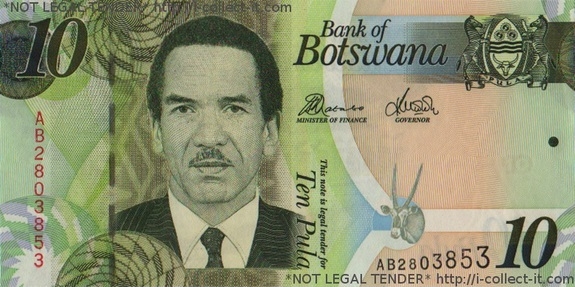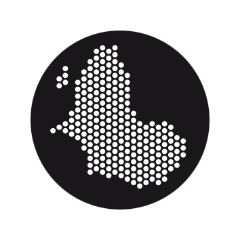The 2015 AIPC-ZAM Investigations
Presidential arms dealers and securocrats rule Africa’s ‘success story.’
Botswana is mostly known from stories about ‘authentic’ tribes living in the Kalahari desert area, rich diamond deposits, relative prosperity, democracy and books about a lovable detective called Mma Ramotswe. In reality however, the tiny country squeaks under the weight of a massive money-guzzling army that made President Khama’s brothers as rich as it made various international arms dealers. An AIPC-ZAM team unearthed an old warning letter, traced missing documents and followed the money amid a recent ‘securocrat’ clampdown on opponents, transparency and media.
In 1981, a British High Commissioner warned in a letter to his superiors at home in London that the Botswana Defence Force had become a “monster absorbing more of the countries national wealth than can be afforded.” Formally attributing that comment to then Bank of Botswana Governor –later president- Festus Mogae, Commissioner Turner made it clear that he was quoting Mogae with much approval, saying that ‘at least I am not alone’ in the concern that the military build-up was ‘diverting funds from worthwhile projects.” As could be gleaned from the first sentence in the letter –“I am sure you will think that by now I am paranoid about the BDF,”- his superiors didn’t take High Commissioner William Turner’s concerns very seriously (1).
The international image of Botswana was then, as it is now, that of a peaceful, friendly country, with the historical honour of having had the first ever black-and-white presidential couple in the world. Post-independence founding president Seretse Khama and his wife Ruth (neé Williams, from the UK), parents of current president Ian Khama, were cherished by all who were into modern race relations and new, mutually beneficial, relationships between post-colonial Africa and the west.
Reports that a new ‘monstrous’ army –gobbling up close to four percent of the country’s GDP in 1980 (2)- had been set up because of ‘pressure’ of their son Ian ‘through his mother,” (3) did not fit with that narrative and were thus duly ignored.
White threats
There were real arguments to support heavy spending on the military in 1981. Up to 1977, Botswana had never had an army, mainly because President Seretse Khama had held a steady focus on development and rather preferred to spend on health and education. But in the late seventies, -whilst, incidentally, Khama’s health was failing; he developed heart ailments and diabetes, and died of pancreatic cancer in 1980- apartheid South Africa and white Rhodesia had become a threat to the country’s borders. Many felt that Botswana’s Police Mobile Unit was no longer enough to counter a number of –sometimes bloody- border violations by these neighbours in their pursuit of political opponents (4).
A huge army was deemed necessary ‘to defend the country against apartheid’
If setting up an army was logical, the relatively high budgets allocated to it during those first years can also be understood. Remarkably however, the need for the specific acquisitions, their sizes, cost and uses and how these fitted in a general defence strategy, was never explained either to parliament or public –not even in the apartheid years. A former Cabinet Minister told the AIPC team that parliamentarians at the time “did not even have the required basic knowledge of defense needs to mount any type of criticism against the spending.”
Military expert Dan Henk seems to doubt, though, whether there was ever even a point in trying to match powerful South Africa’s army. “Botswana’s military improvements could never match its neighbour’s might, nor could the BDF deter attacks against suspected insurgent targets,” he writes in African Security Review in 2004 (5). Henk illustrates this with the example of the “brazen, large-scale South African raid in June 1985 against African National Congress (ANC) targets in (Botswana’s capital) Gaborone that left six people wounded and twelve dead.”(idem.)
If there is truth to the rumours, reported by Henk in the same article, that “the South Africans had given advance notice of an impending raid and had warned Botswana’s military not to interfere,” Botswana’s military men themselves never really believed in the argument that their army could stand up against the might of the apartheid forces. (And if their suppliers –especially the UK under Thatcher and the US under Ronald Reagan- believed this, they could be accused of much cynicism, since they were supplying the South African Defence Force at the time as well (6).)
Botswana’s UK and US arms partners also supplied the South African Defence Force
Secondly, Botswana kept up the spending. Though military budgets did go down a bit in 1994 with the election of Nelson Mandela as SA’s first democratic president, they were soon up to close to four percent of GDP again in 1998 for no apparent reason (7). In 2014 military expenditure fell to 1,9 percent, but even then the country –now at war with literally nobody, under threat of falling diamond prices (8), and with water, electricity and housing in short supply (9) was still the tenth highest military spender in Africa, ranking 37 on the global ‘big spender’ list –at par with Turkey (10). In late 2015, Botswana taxpayers were forking out over 260 million US$ (11) in a ‘stimulus package’ for the purchase of six new fighter jets with accompanying systems.
Big spending continued after apartheid was gone
The Khama family
Botswana’s numerous million- dollar arms equipment purchases over the past four decades (12) have enriched two parties in particular: one, the mainly European arms manufacturers that sold the tanks, jets, armoured personnel carriers, guns, ammunition, missiles and sundry spare parts: Alvis Vickers (UK), Swiss Pilatus, French Thales, Israeli Elbit and German Steyr-Daimler.
The second party is the Khama family: in particular twins Anthony and Tshekedi Khama, brothers of current President Ian Khama.
The lead in building up the Botswana Defence Force was taken by erstwhile ‘presidential son’ Ian Khama himself, first as deputy and later as full commander of the Botswana defence force. Between 1977 and 1989, Khama was nominally only the deputy to ‘real’ commander Mompati Merafhe. But Khama was the son of the –now late- President and Merafhe was his junior in Botswana aristocracy. It would not have been in Merafhe’s interests to oppose his deputy’s wishes.
Acting together, their proposals for arms purchases and general military spending were never refused. In the words of a senior official who served in the BDF at that time, the Khama-Merafhe duo had “an entitlement that could not be challenged by anyone,” not even the President.
The commanders had ‘an entitlement that could not be challenged by anyone’
By the time parliamentarians and others wisened up a bit in the latter part of the eighties –with the demise of apartheid on the horizon-, it was too late. Firstly, Ian Khama had become full commander of the BDF in 1989. And secondly, Ian’s younger brothers, twins Anthony and Tshekedi– the latter is now also Minister for the Environment, Wildlife and Tourism, -had already established their company Seleka Springs (13) as the dominant agency for military acquisitions for the country.
Up to early 2015 the detail of most of the Khama brothers’ contracts and suppliers contracting parties remained secret and out of the grasp of the Botswana public. But finally, in March that year, opposition parliamentarian Pius Mokgware asked Minister of Defence Shaw Kgathi to to state the companies or organisations which Seleka Springs represented as agents, since 1989 to date, for the supply of goods and services to Botswana Defence Force (BDF) and the Botswana Police Services (BPS). Mokgware further wanted to know details of the contracts and amounts awarded to the companies, as well as the amounts of money Seleka Springs received as payment for its role as agents in each of the contracts.
At first Minister Kgathi denied that the Khama brothers at Seleka Springs had ever been awarded tenders from the BDF between 1989 and 1998, the period whilst Ian Khama was in charge. It was then that, for the first time in Botswana history, a sitting Minister was called a liar by the parliament’s deputy speaker (14), who pointed out that a former minister had already confirmed just that. Kgathi was made to retract his statement and, a few months later, indeed produced a list of contracts and their value.
The Khama brothers’ company documents are missing from the registry
It was a very short list, though, and the total value of the contracts quoted- around US$ 10 million- was almost laughably small in view of the fact that several Seleka Springs deals that could be verified by the AIPC team already come close to about US$ 100 million (15) (not counting the current stimulus package of US$ 260 million.)
Questions have also been raised with regard to the nature and quantities of the equipment that was bought. According to the Botswana Guardian of 12 April 2012, military experts had advised against the 1998 contract for forty-six Armoured Personnel Vehicles to be supplied by Steyr-Daimler. They felt that the tanks were inferior compared to those supplied by manufacturers who were not linked to the Khama brothers. Not to be deterred by such caution, the BDF then went on to –in the same year- award Steyr-Daimler another US$ 10 million contract to supply it with twenty SK Kurassier light tanks at a value of US$ 10million. However, at the signing of this contract, the BDF already had 32 Kurrassiers in its fleet.
As if this wasn’t –literary- overkill already, the new tanks then also, like their elder siblings, required the installation of twenty FL-12 105mm turrets. These were included in the deal and contracted to Thales, the major supplier of military equipment and systems for which Seleka Springs also holds the agency licence in Botswana.
Securocracy
The concentration of military power in the presidency, presidential brothers and a few other anointed friends and relatives (16) has accompanied the growth of a Khama-led securocracy in Botswana. Even President Festus Mogae, who headed the country’s government from 1998 to 2008 could, according to sources close to him, do very little to counter the rise of the ‘military millionaires’. A number of corruption investigations into the military and security departments, initiated under Mogae’s government -in which Khama was a Minister as well as Vice President, and Khama’s cousin Ramedulaka Seretse was Minister of Defence- went nowhere. A source close to Mogae says that the former President to this day remains silent about his failed corruption investigation efforts out of fear of ‘victimisation.’
Former President Festus Mogae tried to investigate corruption around the Khamas
In 2008, when Ian Khama was sworn in as Mogae’s successor, Khama promoted his private secretary Isaac Kgosi – a faithful friend from the army, for whom he had especially created the secretarial post- to now head the newly established Directorate for Intelligence and Security.
Establishing a powerful DIS in that same year 2008 had also been Khama-driven. The law that established it, forcefully supported by the then Vice President, gave its agents fire-arms as well as wide-ranging arrest and detention powers (17). It soon became notorious for using these powers to suppress opposition: in 2009, striking students were abducted, threatened and intimidated; twelve ‘suspects’ were shot in broad daylight and with impunity (idem).
Subsequent extrajudicial killings were not so much about social protest, but seemed to center more on corruption, scandal and extortion around Ian Khama and his circle of close friends and relatives. Still in 2009, a former Khama friend, John Kalafatis, was shot in broad daylight and in public on the streets of Gaborone; it was alleged that he had tried to blackmail ‘high profile’ individuals with an incriminating videotape (idem). In 2010, state diamond mining company Debswana’s managing director Louis Nchindo’s body was found, eaten by cheetahs, in the bush: he had allegedly threatened to lift the lid on a diamond-funding scandal from which the ruling party had benefited (idem).
|
In February 2012, the body of IT company owner and DIS contractor Harry Tembo’s body, riddled with both bullets and axe wounds, was found under a bridge bordering the upmarket suburb of Phakalane in the north of Gaborone. Tembo had been a personal acquaintance of some individuals at the highest level of the secret service. In 2011, he had turned chief witness in an enquiry by the state anti-corruption agency DCEC (Directorate on Corruption and Economic Crime) into DIS chief Isaac Kgosi’s business dealings (18).
Among the subject of these enquiries were DIS tenders totaling close to six million US$ which had been given to four companies owned by Kgosi himself and two associates. The associates had also obtained contracts to build President Khama’s controversial home in Mosu, which was constructed with the help of army vehicles (19). Kgosi himself is director of a company, Silver Shadows, that provides private security for state diamond mining company Debswana (20).
One year later, in 2013, the DCEC was brought under the control of the Office of the President, as was the DIS and the investigation came to a halt. In 2014, Gaborone resident Philip Tlhage was arrested, detained and interrogated by DIS agents after he had been overheard by DIS agents at a shopping complex making negative comments about the President. Tlhage later sued the agency and was granted close to US$ 300,000 in damages (21).
The opposition leader died in a car accident
Also in 2014, -the election year that renewed the mandate of President Ian Khama-, the DIS prepared ‘sedition’ charges against –and briefly jailed- Sunday Standard editor Outsa Mokone, the editor of a newspaper that had investigated corruption in the security establishment in the run up to the elections. DIS was also suspected to have hacked the website of the investigative weekly Mmegi and jammed the popular radio Gabz FM, which was hosting political debates before the elections (22).
Two months –and-a-bit before the same elections, on 30 July 2014, opposition leader Gomolemo Motswaledi died when his car rolled over about 90 kilometers south of Gaborone. Botswana police have released a statement pronouncing it a traffic accident, but members of the opposition were and are convinced that this was an assassination (23).
On 26 October 2014 Ian Khama was re-elected president of Botswana.
On 6 May 2015 the offices of the Botswana Gazette were raided by Botswana government officials with an urgent warrant to search and confiscate any material used for the publication of a recent story about individuals who had used their influence in the ruling party to secure oil contracts (24).
President Ian Khama is presently engaged in visiting suppliers for new BDF jets in South Korea and Sweden (25).
This story is part of a Transnational Investigation project series initiated by the African Investigative Publishing Collective (AIPC) in cooperation with ZAM in the Netherlands. This specific investigation was carried out by The Business Weekly & Review (Botswana) in partnership with VICE News correspondent Matteo Civillini.
Some findings on the aspect of the rising securocracy in Botswana were already published earlier by Tshireletso Motlogelwa in The Business Weekly & Review, Mmegi and the ZAM Chronicle.
‘Military millionaires’ was published late last year by Tshireletso Motlogelwa and Matteo Civillini in the Business Weekly & Review
22 March, 2016 | Author Tshireletso Motlogelwa is being sued by Collins Newman, a legal firm that usually acts for Botswana’s president Ian Khama. The firm's defamation suit follows Motlogelwa’s covering of a court case that found the firm had forged documents and lied under oath. Read that particular offending article here: http://www.businessweekly.co.bw/collins-newman-a-web-of-connections/.
Did you miss our first investigations?
For 'Feeding the parasites: how donor campaigns are setting the fight against malaria back' click here.
For 'The Siren Call: how jihadi movements recruit their followers' click here.
Notes
(1) www.documentcloud.org/documents/2718956-UK-Letter-Expressing-Concerns-Over-Khama-s-Army.html and https://www.documentcloud.org/documents/2718960-UK-Letter-Expressing-Concern-Over-Khama-s-Army.html
(2) From SIPRI data gathered by the Norwegian statistics department. See page 17 on Botswana. For general stats on countries’ military spending over the years in % of GDP see: http://data.worldbank.org/indicator/MS.MIL.XPND.GD.ZS?page=2
(3) See (1)
(4) According to military scholar and BDF expert Dan Henk, “this (the need for Botswana military capacity, ed.) was made painfully clear in February 1978, when, responding to reports of a Rhodesian military incursion along Botswana's north-eastern border near the village of Lesoma, a BDF-mounted patrol drove directly into a Rhodesian ambush, sustaining 15 dead,” in https://www.issafrica.org/pubs/ASR/13No4/EHenk.htm
(5) www.issafrica.org/pubs/ASR/13No4/EHenk.htm
(6) See this complaint against US Ford https://www.documentcloud.org/documents/2724563-United-States-Ford-SADF-Collaboration-Complaint.html and this UK anti apartheid movement report on UK supplies to the SADF, notably in the Thatcher era https://www.documentcloud.org/documents/2724564-UK-AAM-Report-on-UK-Military-and-Dual-Purpose.html
(7) See data.worldbank.org/indicator/MS.MIL.XPND.GD.ZS?page=2
(8) Idex Diamond Index report 2nd February 2016: www.idexonline.com/FullArticle?Id=41599
(9) A February 2016 dam levels report by the Water Utilities Board announced water shortages for greater Gaborone for the next four months: http://www.wuc.bw/wuc-content.php?cid=109 and http://www.mmegi.bw/index.php?aid=58152&dir=2016/february/29. On electricity see allafrica.com/stories/201510141446.html and on settlement space http://www.mmegi.bw/index.php?aid=50503&dir=2015/april/14.
(10) See: hornaffairs.com/en/2011/06/12/africa-top-25-military-spending-countries/ and www.indexmundi.com/g/r.aspx?t=50&v=132&l=en.
(11) Figure derived from estimations by BDF sources based on the 6 KAI T-5 planes it is considering to buy.
(12) www.tandfonline.com/doi/abs/10.1080/10246029.2004.9627322 from over 34 million US$ in 1985 to US$ 228 million in 2003
(13) See Defence Minister Kgathis admission that Seleka Springs acted for military purchases from 1989 here: https://www.documentcloud.org/documents/2752456-Minister-Kgathi-on-Seleka-Springs-BOPA-7-7-2015.html. By 1997 the company was reported to be dominating tenders at the BDF (See Kenneth Good: Diamonds, dispossession and democracy http://www.saiia.org.za/opinion-analysis/kenneth-good-diamonds-dispossession-and-democracy-in-botswana-jacana-media-johannesburg-2009, p. 71)
(14) www.sundaystandard.info/speaker-calls-minister-kgathi-order-lying-parliament
(15) See www.documentcloud.org/documents/2752457-SIPRI-Trade-Register-1950-2015-Showing-Companies.html
(16) mg.co.za/article/2012-11-02-00-khama-inc-all-the-presidents-family-friends-and-close-colleagues
(17) www.documentcloud.org/documents/2752778-Emerging-State-Terrorism-in-Botswana.html
(18) www.mmegi.bw/index.php?aid=7969
(19) www.mmegi.bw/index.php?aid=45791
(20) www.mmegi.bw/index.php?aid=48277
(21) www.mmegi.bw/index.php?aid=45632
(22) mg.co.za/article/2015-01-29-spies-hacked-papers-website
(23) www.mmegi.bw/index.php?aid=45367
(24) mg.co.za/article/2015-05-07-botswana-gazette-journalists-arrested-over-story
(25) www.businessweekly.co.bw/bdf-experts-say-no-to-korean-deal/


